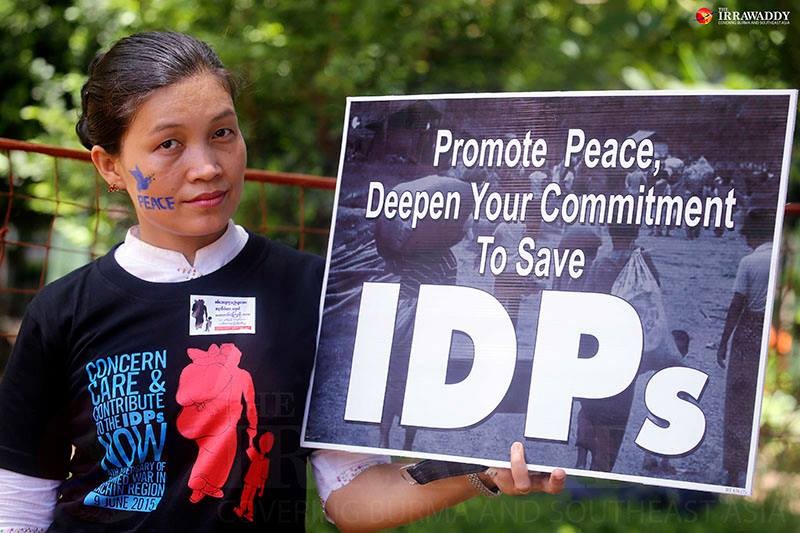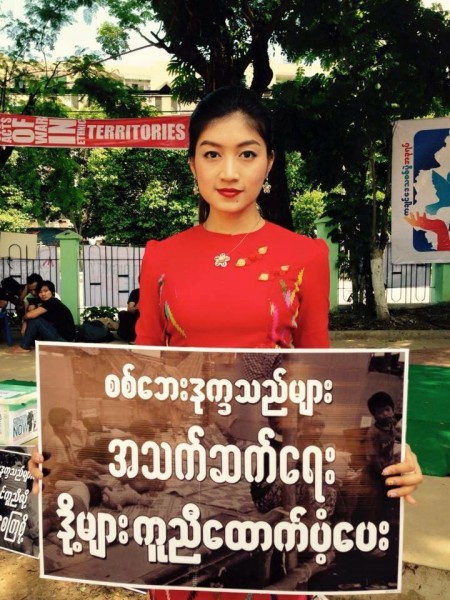Four years ago, a clash between government soldiers and rebels from the Kachin Independence Army in northern Myanmar renewed civil war in Kachin State.
The Kachin Independence Organization, formed shortly after Myanmar’s independence from Britain, pursued the path of armed struggle for 33 years from 1961 until 1994, after which they signed a ceasefire agreement with the military-backed government. The ceasefire lasted for 17 years and was dissolved only when fighting erupted again in June 2011.
The June 2011 clashes displaced thousands of people who fled to the Chinese border to escape the fighting. Many of them are still living in makeshift camps near the border four years after the resumption of hostilities between the government and rebel forces.
To commemorate this and to raise awareness, hundreds of youth and civil society groups gathered on June 7, 2015, in the former capital city Yangon to call for an end to hostilities and gather support for internally displaced persons (IDP). The event was called “Concern, Care, and Contribute to the IDPs Now”.
According to UNHCR, over 100,000 people have been displaced as result of this renewed fighting between the government and the ethnic armed forces. International aid organizations have direct access only to the IDP camps in government-controlled areas.

Photo by the Irrawaddy News Agency and shared by Refugee Stories on Facebook

Photo shared on Facebook by Kachin Life Stories. The placard reads “Protect the Lives of War Refugees”

Photo shared by Ah Phu Phu on Facebook. The placard reads: “Raise the Dignity of War Refugees by Supporting Them”.
On Facebook, Khon Ja from Kachin Peace Network remembered the experience of the villagers on the night the conflict started four years ago:
Local villagers ran in the rain overnight for survival without bringing anything for they assumed it might be temporary hiding as the way they experienced before year 1994.
Today is exactly 4 years that they could not return back… just staying at the falling camps and survive 40 cent/day/person..
Burma Partnership, a network of advocacy organizations, released a statement with support from 56 solidarity groups, calling for an immediate stop to all hostilities and unlimited access for humanitarian organizations to aid thousands of IDPs living in the northern border.
Lahpai Seng Raw from Metta Development Foundation gave a speech about the conditions of the people displaced as a result of war. She said:
There are about 120,000 IDPs, living in deplorable conditions in 172 camps across Kachin and northern Shan States. The anxieties and challenges the IDPs face on a day-to-day basis continue unabated. In fact for some, the situation has become much worse.
She also highlighted the loss of education opportunities for the IDP children:
At borderland camps, there are about 15,000 children of school-going age with limited access to schools and other education opportunities. This year they face special difficulties as UNICEF and local aid organizations are no longer able to provide them with text books and other school materials as in previous years.
She said women living in the areas are particularly vulnerable to abuses:
Also, in the course of this four year war, the lives of those who remain behind are as much in danger as those who flee. Egregious rights abuses are being committed against civilians with impunity, and Kachin women in particular, have become increasingly vulnerable as targets of rape and sexual abuse.
In an interview with the Irrawaddy News Agency, Mary Tawn from local relief agency Wunpawng Ninghtoi reflected the feelings of those living in the camps:
Many elderly persons and some others are suffering from mental trauma, they feel hopeless. The number of students who no longer want to continue their education has increased. Whenever I talk to them they ask me the same thing: “When will we go home?” I’m always speechless and, in fact, I have been asking myself the same question.
The Kachin Peace Network is appealing for more support:
With continued fighting and only 17% of basic needs being met, the situation of Myanmar's IDPs is particularly worrying, and they are in desperate need of greater funding and financial support.
As the war continues, the situation in the camps shows no sign of improvement. Aid from international organizations has dwindled which led to food scarcity in many remote camps.
Myanmar's refugee crisis continues to worsen. Aside from the 100,000 Kachin IDPs near the Chinese border, there are also 140,000 Rohingya refugees in Sittwe township of Rakhine State, and 230,000 IDPs living in southeast region of Myanmar who need immediate humanitarian assistance. Meanwhile, 120,000 refugees living in western Thailand are waiting for their resettlement back to Myanmar.









9 comments